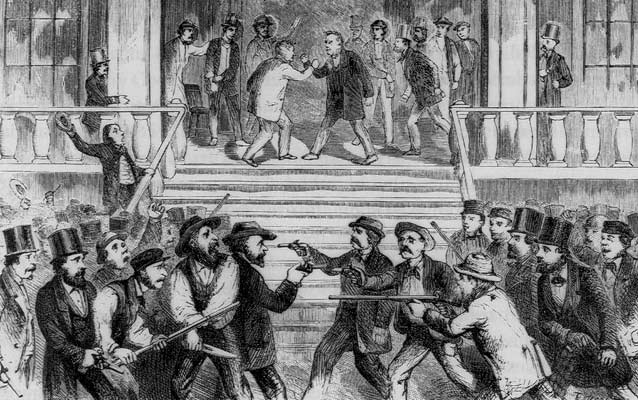Students began class by completing a self-evaluation of their Historiography Essay.
1) Answer this question: Why is understanding what Historiography is important to someone studying history?
2) Underline your thesis statement.
3) Circle where you use the term "historiography" and put a star in the right hand margin where this occurs (only necessary once).
4) Verify that you have full name, date, Zartler/period and a title on the first page.
5) Using the scoring guide evaluate this essay and say whether it Meets; Does Not Meet; or Exceeds the standards. Be specific in regards the bullets in the scoring guide and specific in regards the text of your essay.
6) Given the evaluation above, what grade would you assign this essay, and why do you believe this grade is appropriate.
Exceeds (4)
|
Meets (3)
|
Does Not Meet (2 or 1)
|
|
|
|
|
|
|
|
|
|
|
|
|
|
|
|
After turning in essays the class discovered the "Gains and Setbacks" of Reconstruction. Looking at Reconstruction is a "flash forward." After seeing some of the results of Reconstruction, the class looked back to the some of the major issues facing the country prior to the war.
The Missouri Compromise
The Missouri Compromise was basically eliminated by the Kansas-Nebraska Act:
The Kansas-Nebraska Act was passed by the U.S. Congress on May 30, 1854. It allowed people in the territories of Kansas and Nebraska to decide for themselves whether or not to allow slavery within their borders. The Act served to repeal the Missouri Compromise of 1820 which prohibited slavery north of latitude 36°30´.
This led to a state of civil unrest/ domestic terrorism known as "Bleeding Kansas" or "Bloody Kansas". Abolitionists (including John Brown) and pro-slavery people assaulted, fought, and killed one another in an effort to prevail in the vote on whether there would be slavery in the Kansas Territory.

John Brown and the raid on Harper's Ferry (Arsenal)
John Brown, in an effort to instigate a revolt of enslaved people attacked and took over the Federal Arsenal at Harper's Ferry, VA. The general uprising he hoped to instigate did not materialize.
John Brown, in an effort to instigate a revolt of enslaved people attacked and took over the Federal Arsenal at Harper's Ferry, VA. The general uprising he hoped to instigate did not materialize.
Dred Scott

Dred Scott v. Sandford, 60 US 393 (1857), also known simply as the Dred Scott case, was a landmark decision by the United States Supreme Court on US labor law andconstitutional law. It held that "a negro, whose ancestors were imported into [the U.S.], and sold as slaves", whether enslaved or free, could not be an American citizen and therefore had no standing to sue in federal court, and that the federal government had no power to regulate slavery in the federal territoriesacquired after the creation of the United States.Dred Scott, an enslaved man of "the negro African race" who had been taken by his owners to free states and territories, attempted to sue for his freedom. In a 7–2 decision written by Chief Justice Roger B. Taney, the court denied Scott's request. The decision was only the second time that the Supreme Court had ruled an Act of Congress to be unconstitutional. (https://en.wikipedia.org/wiki/Dred_Scott_v._Sandford)
No comments:
Post a Comment